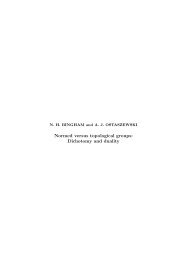Game Theory Basics - Department of Mathematics
Game Theory Basics - Department of Mathematics
Game Theory Basics - Department of Mathematics
You also want an ePaper? Increase the reach of your titles
YUMPU automatically turns print PDFs into web optimized ePapers that Google loves.
2.5. BACKWARD INDUCTION 31<strong>of</strong> the game up to then. <strong>Game</strong> trees can be enhanced with an additional structure thatrepresents “imperfect information”, which is the topic <strong>of</strong> chapter 4.Note how game trees differ from the combinatorial games studied in chapter 1:(a) A combinatorial game can be described very compactly, in particular when it is givenas a sum <strong>of</strong> games. For general game trees, such sums are typically not considered.(b) The “rules” in a game tree are much more flexible: more than two players and chancemoves are allowed, players do not have to alternate, and pay<strong>of</strong>fs do not just stand for“win” or “lose”.(c) The flexibility <strong>of</strong> game trees comes at a price, though: The game description is muchlonger than a combinatorial game. For example, a simple instance <strong>of</strong> nim may requirea huge game tree. Regularities like the mex rule do not apply to general game trees.2.5 Backward inductionWhich moves should the players choose in a game tree? “Optimal” play should maximisea player’s pay<strong>of</strong>f. This can be decided irrespective <strong>of</strong> other players’ actions when theplayer is the last player to move. In figure 2.2(b), player I maximises his pay<strong>of</strong>f bymove A at both his decision nodes, because at the left node he receives 1 rather than 0with that move, and at the right node pay<strong>of</strong>f 2 rather than 1. Going backwards in time,player II has to make her move a or p at the root <strong>of</strong> the game tree, where she will receiveeither 1 or 0, assuming the described future behaviour <strong>of</strong> player I. Consequently, she willchoose a.This process is called backward induction: Starting with the decision nodes closestto the leaves, a player’s move is chosen which maximises that player’s pay<strong>of</strong>f at the node.In general, a move is chosen in this way for each decision node provided all subsequentmoves have already been decided. Eventually, this will determine a move for every decisionnode, and hence for the entire game. Backward induction is also known as Zermelo’salgorithm. (This is attributed to an article by Zermelo (1913) on chess. Later, peopledecided that Zermelo proved something different, in fact a more complicated property, sothat Zermelo’s algorithm is sometimes called “Kuhn’s algorithm”, according to a paperby Kuhn (1953), which we cite on page 96.)The move selected by backward induction is not necessarily unique, if there is morethan one move giving maximal pay<strong>of</strong>f to the player. In the game in figure 2.1, backwardinduction chooses either move b or move c for player II, both <strong>of</strong> which give her pay<strong>of</strong>f 5(which is an expected pay<strong>of</strong>f for move b) that exceeds her pay<strong>of</strong>f 4 for move a. At theright-most node, player I chooses Q. This determines the preceding move d by player IIwhich gives her the higher pay<strong>of</strong>f 3 as opposed to 2 (via move Q). In turn, this meansthat player I, when choosing between X, Y , or Z at the root <strong>of</strong> the game tree, will getpay<strong>of</strong>f 2 for Y and pay<strong>of</strong>f 1 for Z; the pay<strong>of</strong>f when he chooses X depends on the choice<strong>of</strong> player II: if that is b, then player I gets 2, and can choose either X or Y , both <strong>of</strong> whichgive him maximal pay<strong>of</strong>f 2. If player II chooses c, however, then the pay<strong>of</strong>f to player Iis 4 when choosing X, so this is the unique optimal choice. To summarise, the possible
















